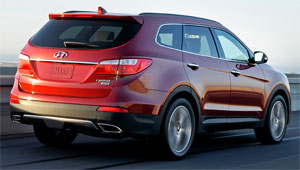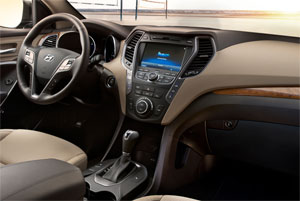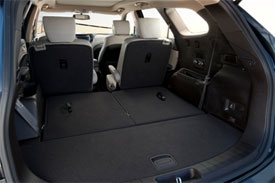2013 Hyundai Santa Fe
The Hyundai Santa Fe has staked quite a claim for itself in the vast expanse of two-row crossover land. On the other hand, Hyundai’s 3-row Veracruz didn’t do so well. So why not try to fix that by capitalizing on the Santa Fe name? So along with the recently introduced 5-passenger Santa Fe Sport comes a new 7-passenger model named simply, Santa Fe. Will all of that shuffling result in a winning hand? Well it’s time to place your bets!
Without a doubt, Hyundai has certainly gone “all-in” in recent years, with a nearly constant onslaught of fresh products and new segment entries. The newest goes by a familiar name, the 2013 Hyundai Santa Fe. It competes against other mid-to-larger three-row crossovers like the Mazda CX-9, Honda Pilot, and Chevrolet Traverse, just to name a few.
 Compared to the new two-row Santa Fe Sport, the Santa Fe is 8 ½ inches longer; riding on a stretched 110.2 inch wheelbase. Like most rivals, a V6 powertrain is standard. Here it’s the Azera’s 3.3-liter V6 feeding power to the front or all-wheels through a 6-speed automatic. Horsepower is 290, with torque coming in at 252 lb-ft.
Compared to the new two-row Santa Fe Sport, the Santa Fe is 8 ½ inches longer; riding on a stretched 110.2 inch wheelbase. Like most rivals, a V6 powertrain is standard. Here it’s the Azera’s 3.3-liter V6 feeding power to the front or all-wheels through a 6-speed automatic. Horsepower is 290, with torque coming in at 252 lb-ft.
The combo is good for Government Fuel Economy Ratings of 18–City, 25-Highway, and 21–Combined in 2-wheel-drive models. We averaged a good 22.0 miles-per-gallon of Regular in mixed driving. It also offers a good amount of muscle for daily duties, including good passing power and towing up to 5,000 pounds.
Being a family SUV, it’s what’s inside matters the most, and here our feelings about the new Santa Fe are more mixed.
 Everything looks nice; the layout is fine; with deep hooded gauges, an easy to use center stack, and standard Blue Link telematics. But the environs come off as less expensive as both the old Veracruz and newer rivals like the Nissan Pathfinder. Seats are comfortable, but again the cushions grab us as short and thin. In Limited trim the second row is Captain’s Chairs for a capacity of six. Our 7-seat GLS had a 40/20/40 split bench, with a 60/40 slider as an option.
Everything looks nice; the layout is fine; with deep hooded gauges, an easy to use center stack, and standard Blue Link telematics. But the environs come off as less expensive as both the old Veracruz and newer rivals like the Nissan Pathfinder. Seats are comfortable, but again the cushions grab us as short and thin. In Limited trim the second row is Captain’s Chairs for a capacity of six. Our 7-seat GLS had a 40/20/40 split bench, with a 60/40 slider as an option.
Ease of access to the 50/50 split third row is good, and it does provide surprising room for adults along with its own climate controls. Maximum cargo capacity is a respectable 80.0 cubic-ft, with 40.9 behind the second row, and 13.5 behind the third. Our GLS tester did not include the Limited’s power rear hatch, but the lift gate is very light, so we didn’t feel that it was necessary.
Neither is running quarter miles in this family wagon, but that’s what we do, so off to the track we went for a 0-60 time of only 7.4 seconds, and a sprint through the quarter of 16.0-seconds flat at 90 miles per hour. Braking from 60 felt very good for a mass market hauler. Stops averaged an acceptable 131-feet with immediate response and feedback from the nice firm pedal. But dodging cones was not so impressive; with slow steering, plenty of body roll, and a clumsy feel that all work together to constantly remind you how big the new Santa Fe really is.
 The Santa Fe features sharper lines over the rear wheels, has chrome-tipped dual exhaust, a tow hitch cover, a slightly different take on the grille, and 18-inch wheels.
The Santa Fe features sharper lines over the rear wheels, has chrome-tipped dual exhaust, a tow hitch cover, a slightly different take on the grille, and 18-inch wheels.
Santa Fe pricing starts at a class reasonable $29,455, with the Limited model starting at $34,025. All-wheel-drive is available on either model for $1,750 more.
The 2013 Santa Fe is all around competent and a good value, if not really a standout. A nice vehicle, but clearly a step down in image from the Veracruz it replaces. Still, the Santa Fe name may be just what it takes to give Hyundai a serious player in the larger crossover segment.
Specifications
- Engine: 3.3-liter V6
- Horsepower: 290
- Torque: 252 lb-ft.
- 0-60 mph: 7.4 seconds
- 1/4 mile: 16.0 seconds @ 90 mph
- EPA: 18 mpg city/ 25 mpg highway
2024 Polestar 2
More Range And More Power For The Polestar 2
Volvo is well on their way to making the transition to an all-electric brand, but their sister-brand Polestar is already there. Now, we’ve spent lots of time in their all-wheel drive, five-door Polestar 2, having tested it in 2021, and a year later when a two-wheel drive version arrived. But, EV updates are coming quickly. So, let us be your guide for all that’s new with the Polestar 2.
While we are driving more EVs than ever, we’ve also been spending a lot of time recently circling back to ones we’ve previously tested. As in this new era of electrified vehicles, significant updates are arriving quickly, with R&D investments increasing and retrofitting them easier than ever. This is often done through software updates that can even be accomplished over the air. For 2024, the Polestar 2 has indeed gotten some software updates, but some physical ones as well.
Clearly aimed directly at Tesla’s Model 3 when it arrived; the Polestar 2’s build quality was vastly better, but range definitely came up short. So, addressing that was priority No. 1; and for ’24 the Polestar can travel up to 20% farther than before while consuming 9% less energy, and when it comes time to charge it back up, it can do that 34% faster too.
Range in the Single Motor version increases from a max of 270 to 320 miles thanks to a larger 82-kWh battery pack, and that solitary motor now powers the rear wheels, not the front wheels. It’s also bigger, coming in at 220 kW compared to the previous 170 kW front-wheel drive version, going from 231 to 299 horsepower.
Dual Motors keep the same 78-kWh battery, but still sees a boost from 260 to 276 miles and takes advantage of the larger rear motor for a new combined 310-kW output with 421 horsepower. Our test car has the added Performance Pack, which uses an additional 35 kW to deliver 455 horsepower and 546 lb-ft of torque, though max range drops to just 247 miles.
The new battery in rear-drive 2s will also charge faster, now accepting up to 205 kW for an 80% charge in 20 minutes; max for dual-motors stays at 155 kW, which puts an 80% charge at 34 minutes. Using 32 kWh of electricity per 100 miles, the Dual Motor earns a good efficiency rating.
The [Polestar] 2 has always been one of the most enjoyable EVs to drive, even more so now with that additional power coming from the rear motor.
Unfortunately, extremely cold temperatures kept us from seeing that increased range, as we were only on pace for about 194 miles in our test.
The 2 has always been one of the most enjoyable EVs to drive, even more so now with that additional power coming from the rear motor. And especially when equipped with the Performance Pack as it not only includes more power, but adds 20-inch forged wheels, upgraded brakes, and adjustable Ohlins Dual Flow Valve performance dampers. It greatly improves handling prowess without affecting ride quality, and is easily worth the $5,500 charge if you at all enjoy driving.
Even on a 20-degree track day there was plenty of grip through our handling course. No understeer or oversteer, and lots of feedback through the wheel. There was a nice, strong launch off the line that properly planted us firmly in the seat, and rocketed us to 60 in 4.5 seconds. Power delivery stayed pretty intense up until about 80 mph when there was a definite tapering off. Still, it was a 13.4-second quarter-mile at 102 mph; smooth, quiet, and stable the whole way.
When this car debuted, its Google-based infotainment setup was a novelty, but since then, more and more manufacturers are just “Googling it” so it doesn’t seem out of place at all. The wireless phone charger is easy to access, and there’s a great Harmon/Kardon sound system and panoramic sunroof to enhance the in-cabin experience. Exteriors have also been enhanced with a smooth grille insert and new wheel choices.
Hatchback practicality means 14.3 cu-ft of easy to access cargo space with split-folding seatbacks for longer items and expanding the space to 38.7 cu-ft. Plus, there’s even a sizeable storage bin up front under the hood.
Single Motor Polestar 2 pricing now starts at $51,300, with Dual Motors starting at $56,700; topping out at $64,400.
For a car manufacturer that hasn’t even been around for a decade yet, Polestar has kept itself busy, totally transforming their latest model in just a few years, making the 2024 Polestar 2 even more appealing. They are certainly off to a good start, and with a host of Polestars just over the horizon, including some all-important utility vehicles, this star will be shining even brighter.
Specifications
As Tested
- Motor Setup: Dual Motor
- Horsepower: 455
- 0-60 mph: 4.5 seconds
- EPA Range: 247 miles
- Efficiency : 32 kWh / 100 miles
- Battery Size: 78-kWh
- Torque: 546 lb-ft
- 1/4 Mile: 13.4 seconds at 102 mph
- MW Test Loop: ~ 194 miles
- Peak Charging Rate: 155 kW











































